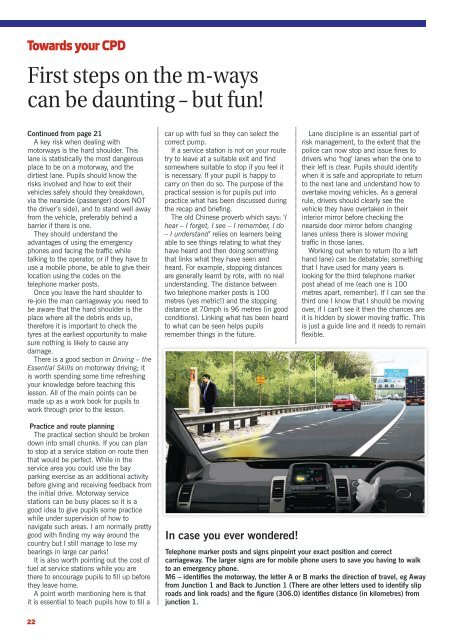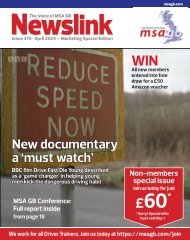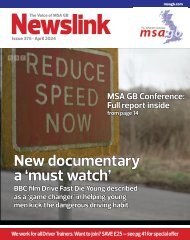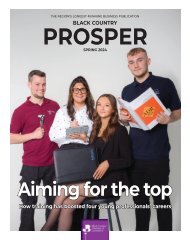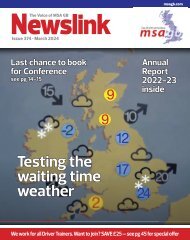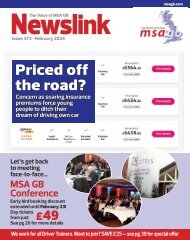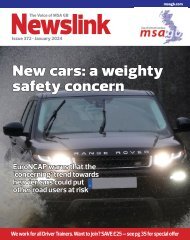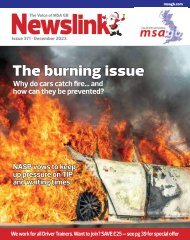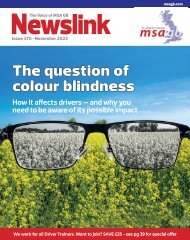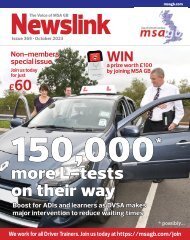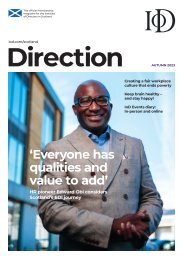Newslink February 2021
Motor Schools Association of Great Britain membership magazine; driver training and testing; road safety.
Motor Schools Association of Great Britain membership magazine; driver training and testing; road safety.
You also want an ePaper? Increase the reach of your titles
YUMPU automatically turns print PDFs into web optimized ePapers that Google loves.
Towards your CPD<br />
First steps on the m-ways<br />
can be daunting – but fun!<br />
Continued from page 21<br />
A key risk when dealing with<br />
motorways is the hard shoulder. This<br />
lane is statistically the most dangerous<br />
place to be on a motorway, and the<br />
dirtiest lane. Pupils should know the<br />
risks involved and how to exit their<br />
vehicles safely should they breakdown,<br />
via the nearside (passenger) doors NOT<br />
the driver’s side), and to stand well away<br />
from the vehicle, preferably behind a<br />
barrier if there is one.<br />
They should understand the<br />
advantages of using the emergency<br />
phones and facing the traffic while<br />
talking to the operator, or if they have to<br />
use a mobile phone, be able to give their<br />
location using the codes on the<br />
telephone marker posts.<br />
Once you leave the hard shoulder to<br />
re-join the man carriageway you need to<br />
be aware that the hard shoulder is the<br />
place where all the debris ends up,<br />
therefore it is important to check the<br />
tyres at the earliest opportunity to make<br />
sure nothing is likely to cause any<br />
damage.<br />
There is a good section in Driving – the<br />
Essential Skills on motorway driving; it<br />
is worth spending some time refreshing<br />
your knowledge before teaching this<br />
lesson. All of the main points can be<br />
made up as a work book for pupils to<br />
work through prior to the lesson.<br />
car up with fuel so they can select the<br />
correct pump.<br />
If a service station is not on your route<br />
try to leave at a suitable exit and find<br />
somewhere suitable to stop if you feel it<br />
is necessary. If your pupil is happy to<br />
carry on then do so. The purpose of the<br />
practical session is for pupils put into<br />
practice what has been discussed during<br />
the recap and briefing.<br />
The old Chinese proverb which says: ‘I<br />
hear – I forget, I see – I remember, I do<br />
– I understand’ relies on learners being<br />
able to see things relating to what they<br />
have heard and then doing something<br />
that links what they have seen and<br />
heard. For example, stopping distances<br />
are generally learnt by rote, with no real<br />
understanding. The distance between<br />
two telephone marker posts is 100<br />
metres (yes metric!) and the stopping<br />
distance at 70mph is 96 metres (in good<br />
conditions). Linking what has been heard<br />
to what can be seen helps pupils<br />
remember things in the future.<br />
Lane discipline is an essential part of<br />
risk management, to the extent that the<br />
police can now stop and issue fines to<br />
drivers who ‘hog’ lanes when the one to<br />
their left is clear. Pupils should identify<br />
when it is safe and appropriate to return<br />
to the next lane and understand how to<br />
overtake moving vehicles. As a general<br />
rule, drivers should clearly see the<br />
vehicle they have overtaken in their<br />
interior mirror before checking the<br />
nearside door mirror before changing<br />
lanes unless there is slower moving<br />
traffic in those lanes.<br />
Working out when to return (to a left<br />
hand lane) can be debatable; something<br />
that I have used for many years is<br />
looking for the third telephone marker<br />
post ahead of me (each one is 100<br />
metres apart, remember). If I can see the<br />
third one I know that I should be moving<br />
over, if I can’t see it then the chances are<br />
it is hidden by slower moving traffic. This<br />
is just a guide line and it needs to remain<br />
flexible.<br />
Practice and route planning<br />
The practical section should be broken<br />
down into small chunks. If you can plan<br />
to stop at a service station on route then<br />
that would be perfect. While in the<br />
service area you could use the bay<br />
parking exercise as an additional activity<br />
before giving and receiving feedback from<br />
the initial drive. Motorway service<br />
stations can be busy places so it is a<br />
good idea to give pupils some practice<br />
while under supervision of how to<br />
navigate such areas. I am normally pretty<br />
good with finding my way around the<br />
country but I still manage to lose my<br />
bearings in large car parks!<br />
It is also worth pointing out the cost of<br />
fuel at service stations while you are<br />
there to encourage pupils to fill up before<br />
they leave home.<br />
A point worth mentioning here is that<br />
it is essential to teach pupils how to fill a<br />
In case you ever wondered!<br />
Telephone marker posts and signs pinpoint your exact position and correct<br />
carriageway. The larger signs are for mobile phone users to save you having to walk<br />
to an emergency phone.<br />
M6 – identifies the motorway, the letter A or B marks the direction of travel, eg Away<br />
from Junction 1 and Back to Junction 1 (There are other letters used to identify slip<br />
roads and link roads) and the figure (306.0) identifies distance (in kilometres) from<br />
junction 1.<br />
22


